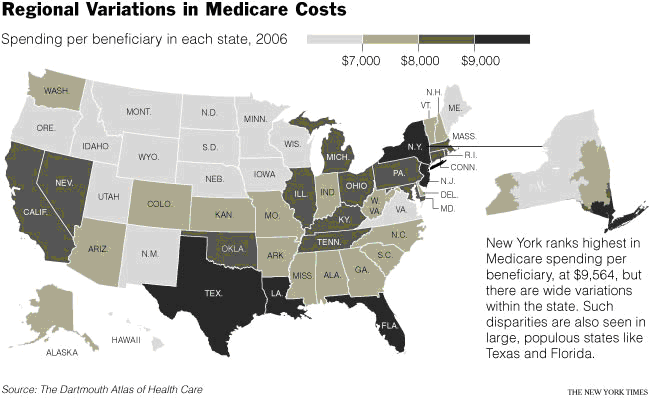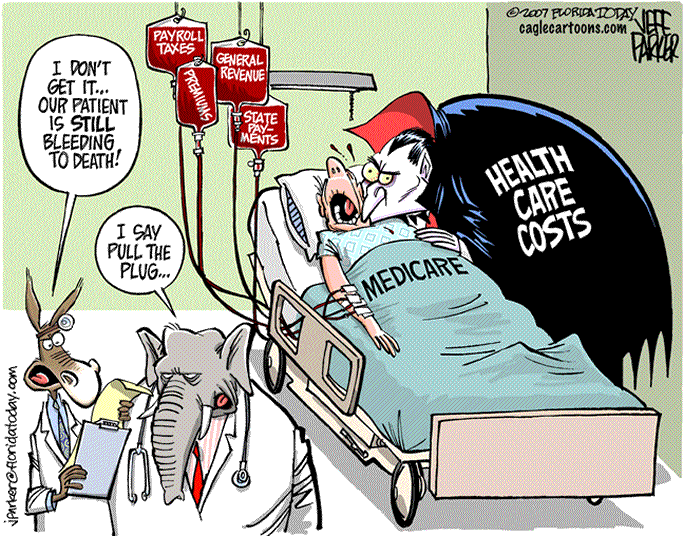Where Does Your State Rank In Medicare Spending?

Is It Fair To Compare?
THIS MAP indicates what each State spends on Medicare.
Once the map pops up, you’ll note that the lightest color shows spending up to $7,000 per Medicare beneficiary, and the darkest shows spending over $9,000.
Nationally, according to the Dartmouth Atlas of Health Care, Medicare spent an average of $8,304 per beneficiary in 2006. Among states, New York hit the high mark at $9,564, and Hawaii was lowest at $5,311.
The burning question is why is there such a cost disparity among States?
After all, even if there were absolutely no further cost efficiencies to be had in the lowest-cost State, if its cost structure could be adopted by the highest-cost State, Medicare could save a whopping $3,689 per beneficiary, or 69% less, in the highest-population State.
Researchers at Dartmouth Medical School have also found wide variations within states and among cities. Medicare spent $16,351 per beneficiary in Miami in 2006, almost twice the average of $8,331 in San Francisco, they said.
Which brings me to today’s article in the New York Times, Data Fuel Regional Fight on Medicare Spending by Robert Pear,which adds fuel to the fiery debate about regional Medicare cost structures and quality outcomes. Because, as you might gather, there are few similarities about Hawaii and New York, or Miami and San Francisco, not only in weather and topography, but other things pertinent to health care costs.
New government data show that, yes (for instance), New York does spend a lot, but when other factors are accounted for — such as cost of living, more intensive medical practices, etc. — New York’s costs are near the national average of Medicare costs per beneficiary. Perhaps so, but then New York only scores at the midway mark for overall quality. (See grid below.)
So, there are two factors in play here:
1. Getting costs and health outcomes in line; and
2. Getting high-cost States to be as cost efficient as low-cost States.
President Obama stresses that the U.S. could save a huge amount of money if doctors and hospitals were as efficient as low-cost States like Hawaii, Iowa and Minnesota. But some, such as the Medicare Payment Advisory Commission (an independent federal group that advises Congress) indicate that it’s not so simple, even conceptually.
As indicated above, this group says that the cost variations are explained by local disparities in the cost of providing care and in the health status of Medicare beneficiaries. After adjusting for such factors, they say, payments per beneficiary were 92% of the national average in New York City and 95% in Boston.
In other words, these high cost places are not really out of whack.
Two camps have emerged from this debate: One holds the view of the Advisory Commission, and the other holds the view of Mr. Obama. These opposing viewpoints are articulated in the New York Times article reference above by Dr. Denis Cortese, president of the Mayo Clinic in Rochester, Minn. and Dr. Steven Safyer, president of Montefiore Medical Center in the Bronx.
Dr Cortese said:
Medicare wasted billions of dollars a year because it “pays the most to health care providers and geographic areas that provide the lowest-quality care at the highest costs.”
Presenting an alternative view, Dr. Safyer said:
“Our Medicare expenditures reflect the low socioeconomic status of the population and the very high cost of doing business here. Many of our patients do not receive regular care before becoming eligible for Medicare and have no one to care for them after they leave the hospital. Our construction costs and wages are also much higher than the national average.”
And I say:
“The debate drums on”.
This grid shows various cities’ Medicare spending per beneficiary and quality outcomes. The grid is interactive and will display the actual costs when you roll your cursor over a particular city.
Last Updated on September 14, 2022 by Joe Garma



